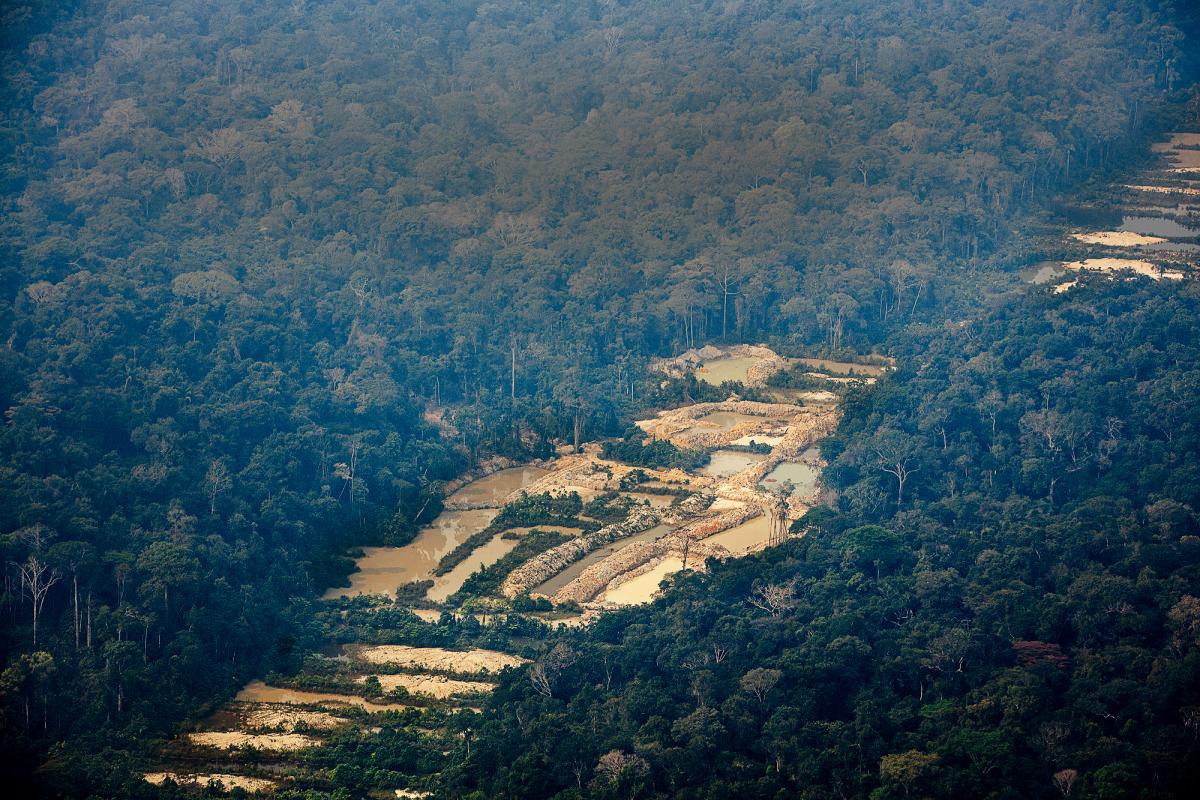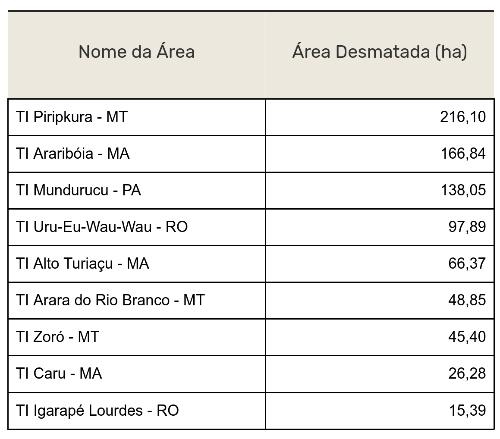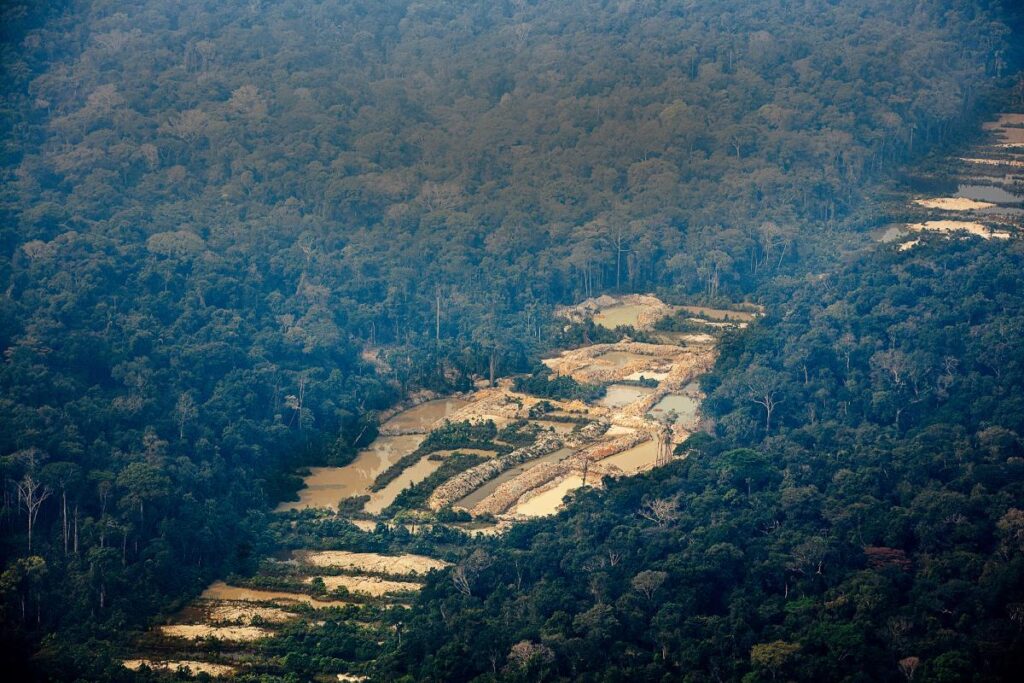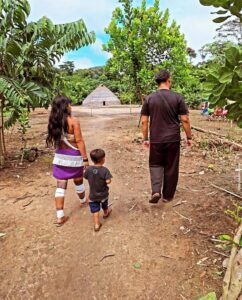Data from the Deforestation Alert System for Indigenous Lands with Records of Isolated Peoples, Sirad-I, 2023 bulletin and from the first quarter of 2024 show that invaders remain on lands with isolated indigenous peoples and are resuming their activities. The bulletin, presented by the Socio-Environmental Institute (ISA) since 2020, this week was launched in partnership with Opi for the first time.
Despite the celebrated slowdown in deforestation in the Amazon, Indigenous Lands with the presence of isolated peoples continued being invaded by illegal gold miners in 2023.
In the Zoró Indigenous Land (IL), there was an 88% increase in deforestation records in 2023 compared to the previous year, showing signs of illegal mining in the territory. In the first months of 2024, this hypothesis was confirmed by the felling of more than 5,000 trees in the area.
In 2023, 90% of deforestation recorded in the Munduruku Indigenous Land was directly related to illegal mining. In 2024, despite a significant reduction in mining activity, the expansion of degraded areas in previous periods indicates the persistence of invaders in the Indigenous Land.

The situation in these and other Indigenous Lands is seen in the two most recent reports from the Deforestation Alert System for Indigenous Lands with Records of Isolated Peoples Sirad-I: Annual 2023 and Sirad-I: January - March 2024launched this Wednesday (07/08) by the Socio-Environmental Institute (ISA), in partnership with the Observatory for the Human Rights of Isolated and Recently Contacted Indigenous Peoples (Opi).
Download:
Sirad-I: Annual 2023
Sirad-I: January - March 2024
With approximately 187,000 km² being monitored, the system has been tracking deforestation alerts in 23 areas with isolated indigenous peoples since 2020 using radar and high-resolution optical images, 21 of which are Indigenous Lands, most of which have confirmed records of isolated peoples, and two Conservation Units (CU). In 2024, monitoring was extended to 26 areas and, as of this year, the publication began to monitor Bananal Island, in the Inãwébohona Indigenous Land, Tocantins state; and outside Indigenous Lands the regions of the Baixo Jatapu/Oriente, Pará state; and Mamoriá Grande, southern Amazonas state, with records of isolated peoples, were incorporated.
The data provided by the annual bulletin shows that despite the 58% reduction in deforestation rates in Indigenous Lands in the Legal Amazon in relation to 2022, as measured by the Prodes/Inpe* rates, the areas with recorded presence of isolated people being monitored had a less significant reduction, of less than 20%. In total, the alert system detected 825.46 hectares of deforestation, the equivalent of cutting down approximately 475,000 trees.
"The worst results in Indigenous Lands with isolated peoples show that they are the most vulnerable areas. For invaders, they are no man's land, ready to be invaded. The Piripkura Indigenous Land is an example of this. An area of Restricted Use and, unfortunately, with little progress in its definitive demarcation process. The delay in demarcating areas with a rUse Restriction Ordinance puts the fate of these peoples to the test," explains Tiago Moreira, anthropologist and researcher at ISA.
"2023 was a year of great expectation regarding the reduction in deforestation rates in the Legal Amazon," the annual report recalled. The first months of monitoring in 2023 were marked by the arrival of the new government, elected with the promise of fighting environmental crimes and ending deforestation - and after Bolsonaro left the presidency with a historic deforestation record in Protected Areas, according to ISA's analysis.
In the first four months of 2023, Sirad-I revealed that deforestation was 28% higher than in the same period in 2022, when 319.6 hectares were deforested in the Indigenous Lands being monitored. Almost half of alerts in this period took place in March.

In the following months, November had the second highest number of alerts in 2023. March and April together accounted for 42% of total deforestation last year, with a quarter registered in the Piripkura Indigenous Land.
The history of invasions in the Piripkura IL is not recent, as explained by indigenist Elias Bigio, former General Coordinator of Isolated and Newly Contacted Indigenous Peoples (CGIIRC) of the National Foundation for Indigenous Peoples (Funai), and currently part of Opi’s team.
"At Piripkura, there are established farms, there is pressure from land grabbers, there is a dispute over Piripkura territory that has already been denounced several times to the Federal Police and the Public Prosecutor's Office. When the first Use Restriction Ordinance was determined in 2008, for example, an action by the Public Prosecutor's Office suspended the activities of the logging companies that were operating there, but there is still pressure in the northern area of the central part of the IL, which has now culminated in a decision by the judge ordering the expulsion of these invaders."
The decision cited by Bigio refers to a public lawsuit, whose final decision by the Juína Court, Mato Grosso state, published in July 2024, ordered the removal of illegal occupants from the IL and cattle from their properties, and the end of deforestation in the territory.
In 2023, the Araribóia, Alto Turiaçu and Caru Indigenous Lands in Maranhão accounted for around 30% of all deforestation recorded in the areas monitored by the bulletin.
The situation in the Araribóia IL was denounced to the Inter-American Commission on Human Rights (IACHR) by the Coordination of Indigenous Organisations of the Brazilian Amazon (Coiab), the Coordination of Organisations and Articulations of Indigenous Peoples of Maranhão (Coapima) and the Guardians of the Forest, an indigenous initiative for monitoring and surveillance of their territories.
The region has been under great pressure in its surrounding area and within the territory, with invasions by illegal hunters and loggers, as well as squatter farmers and smallholders.
From January to March 2024
In the first quarter of 2024, Sirad-I recorded a 75.14% reduction in deforestation in the monitored areas compared to the same period in the previous year. According to the report, the reduction is evidence of the renewal of the protection of these territories, with various operations to remove invaders, as was the case with the Uru-Eu-Wau-Wau Indigenous Land.
Lands in evidence:
Zoró Indigenous Land (RO and MT)
The Zoró Indigenous Land, in the border of Mato Grosso and Rondônia states, next to the Sete de Setembro and Roosevelt Indigenous Lands and the Aripuanã Indigenous Park, make up the so-called Tupi Mondé Ethno-Environmental Corridor, one of the last remaining areas of forest between the two states.
With the increase in alerts in 2023, the first three months of 2024 confirmed evidence of land invasions. Approximately 13,000 trees were felled in the first three months of the year alone, more than 40% of them cleared for illegal mining.
The Zoró Indigenous People's Association (Apiz) had been denouncing the activities of gold miners since December 2023. In April 2024, there were new reports of attacks on indigenous people by loggers.
According to Elis Bigio, reports of the presence of isolated people in the Zoró Indigenous Land are recurrent. "This year, we've had more reports of isolated people in the northern region, which coincides with the greatest pressure from mining and exploitation in the Indigenous Land," he said. "It's the lives of the indigenous people that are at risk," he denounced.
Piripkura Indigenous Land (MT)
The Piripkura Indigenous Land, an area with confirmed records of isolated indigenous people in the west of Mato Grosso, has been waiting almost 40 years for regularisation.
While its legal status remains undefined, the tragic history of invasions and illegal deforestation continues in the land inhabited by the Piripkura people, as Bigio points out: "It results in this appropriation of indigenous heritage, illegal extraction, mainly of minerals and timber, and the establishment of cattle ranches. However, the greatest risk is to the indigenous people themselves, because the Piripkura have almost been exterminated," he says.
Last year, after pressure from indigenous and civil society organisations, the Use Restriction Ordinance was re-established by the president of the National Foundation for Indigenous Peoples (FUNAI), Joenia Wapichana, to last until the IL is officially approved. The measure aims to protect the area and its peoples until the regularisation process is complete.
Not even the operation carried out by the Brazilian Institute for the Environment and Renewable Natural Resources (Ibama)in 2021 was enough to stop the invaders. In 2023, the Piripkura Indigenous Land continued to be invaded and also became the target of fires used to clear land. According to the annual report, over 60% of the total area burnt in 2023 corresponds to areas deforested in 2021.
Between 2020 and 2021, illegal occupations led to the deforestation of almost 2,500 hectares, with the IL accounting for 30% of all deforestation recorded in the history of Sirad-I alerts, from 2020 to 2024.
Araribóia Indigenous Land (MA)
The Araribóia Indigenous Land, located in Maranhão, recorded 147.12 hectares of illegal deforestation in 2023, with 68% of the records occurring in the last four months of the year alone. In addition, fires increased almost fourfold in 2023.
In 2024, the Indigenous Land recorded a total of 10.78 hectares of deforestation in the first three months of the year alone, representing an increase of almost 100% compared to the same period the previous year. Although records were registered in eight areas next to the villages, only 3.20 hectares could be characterised as areas of traditional use.
Alto Turiaçu Indigenous Land (MA)
In the Alto Turiaçu Indigenous Land, the largest in Maranhão and part of the Legal Amazon, monitoring identified the felling of more than 20,000 trees, with more than 50% of deforestation associated with fires. In addition, the annual bulletin also pointed to a 200% increase in the incidence of hotspots in the last four months of the year, which resulted in the burning of a total area of 4,329.62 hectares. In 2022, there were no records of fires.
Faced with this scenario, in December the Ministry of Justice and Public Security (MJSP) authorised the use of the National Guard in the IL as a way of stopping the constant land invasions. After their intervention, in 2024, deforestation fell in the region, most of it being associated with the traditional management of the land.
Munduruku Indigenous Land (PA)
In the Munduruku Indigenous Land, an area with a long history of invasions and illegal mining, 138 hectares of deforestation were recorded in 2023, equivalent to almost 80,000 trees being felled, 90% of it directly linked to the illegal mining operations that cut across the northeast of the IL.
* INPE/PRODES - National Institute for Space Research/Legal Amazon Deforestation Satellite Monitoring Project




